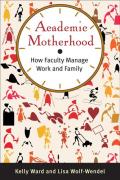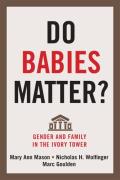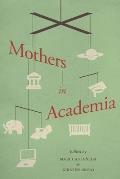- About
- Programs
- Issues
- Academic Freedom
- Political Attacks on Higher Education
- Resources on Collective Bargaining
- Shared Governance
- Campus Protests
- Faculty Compensation
- Racial Justice
- Diversity in Higher Ed
- Financial Crisis
- Privatization and OPMs
- Contingent Faculty Positions
- Tenure
- Workplace Issues
- Gender and Sexuality in Higher Ed
- Targeted Harassment
- Intellectual Property & Copyright
- Civility
- The Family and Medical Leave Act
- Pregnancy in the Academy
- Publications
- Data
- News
- Membership
- Chapters
Motherhood in the US Academy
Academic Motherhood: How Faculty Manage Work and Family by Kelly Ward and Lisa Wolf-Wendel. New Brunswick, NJ: Rutgers University Press, 2012.
Do Babies Matter? Gender and Family in the Ivory Tower by Mary Ann Mason, Nicholas H. Wolfinger, and Marc Goulden. New Brunswick, NJ: Rutgers University Press, 2013.
Mothers in Academia by Mari Castañeda and Kirsten Isgro, eds. New York: Columbia University Press, 2013.
The goal of Kelly Ward and Lisa Wolf-Wendel’s book Academic Motherhood is to counter the folk wisdom within the academy that motherhood is incompatible with life as a successful academic. While the authors know from personal experience that balancing academic work and parenthood is possible, their initial review of the literature turned up very few studies supporting this argument. Likewise, in the small but growing body of literature about mothers in academia, they found that “academic motherhood experiences have been underreported and those available are negative in tone.” And yet, they describe being besieged by graduate students and junior faculty desperate for advice about how to balance work and family life in academia. Both authors are now full professors; they know that success like theirs is possible and initiated this study in an effort to provide analysis and advice for women trying to navigate the often contradictory demands of academic work and parenthood.
This ground has been trod before in books like Mama Ph.D. and Professor Mommy, but Ward and Wolf-Wendel offer the unique contribution of a longitudinal study, following women through different stages of their academic careers. The authors are determined not to seem to be saying, “We did it, so you can too!” On the contrary, their research was profoundly motivated by the desire to change how provosts, deans, department chairs, colleagues, and female faculty members view questions of motherhood and work-family balance. They want to move the discussion from a “narrative of constraint” to a “narrative of possibility.”
Their study looks at several types of institutions: community colleges, comprehensive regional institutions, liberal arts colleges, and research universities. Drawing from a sample of 120 women from a range of disciplinary backgrounds, they interviewed academic mothers before and after tenure. The longitudinal focus allows them to analyze women’s experiences while their children are young and determine whether their experiences as mothers in the academy change once children are older. They place particular emphasis on the unique demands faced by female faculty members in the bench sciences, and they use vignettes to encapsulate the stories of individual female faculty members, highlighting their fears, experiences, struggles, and achievements.
Several of their findings are both illuminating and uplifting. Women report how much they love the intellectual engagement of academic life and enjoy the experience of motherhood. Several women discuss the joy they feel in meeting the challenge of combining personal and professional roles. They highlight the extent to which being a parent not only forces them to set priorities but also enables them to keep work in perspective. These scholars appreciate the flexibility that an academic life allows, and many find the ability to control their own schedules to be highly compatible with their needs as mothers.
However, many women also mention not knowing about leave policies, cobbling together affordable child-care solutions for themselves, or trying to time their pregnancies so that their babies will be born in the summertime. Several of these scholars express fears about being away from their labs or their research for too long; others express guilt about being away from their children. As one put it, “Ever since I had my son, I’ve felt like when I’m with him I should be working, when I’m not with him I should be with him.” Some tenured faculty members complain about burnout and express a reluctance to initiate promotion to full professor.
Ward and Wolf-Wendel analyze all of these concerns through the norms of the “ideal worker.” Motherhood and academic work are both “greedy institutions,” they argue, demanding total commitment and dedication. Academic mothers must negotiate both institutions without sufficient time, support, and resources in either. Many of the mothers in the study cope with these impossible demands through the technique of “satisficing”—accepting conditions at home and work that are “good enough” but not optimal. They suggest that satisficing helps women make acceptable compromises in an effort to manage the various demands for their time and attention. While this entails a recognition that they may not be able to “have it all,” it at least allows women, especially those early in their careers, to feel confident that they are doing the best they can in both domains.
Mary Ann Mason, Nicholas Wolfinger, and Marc Goulden address similar issues in Do Babies Matter? Gender and Family in the Ivory Tower. Their study, based on more than a decade of research—some of it originally published in Academe—is the first comprehensive examination of the relationship between family formation (as defined by marriage and parenthood) and the academic careers of men and women. The book begins with a focus on graduate students and postdoctoral fellows but extends its trajectory throughout the career paths of female and male faculty members as they seek employment, tenure, promotion to full professor, and, eventually, retirement. The authors draw on a wide range of sources, including data from the University of California system and the Survey of Doctorate Recipients; interviews with University of California graduate students, postdocs, and tenure-track faculty members; and online responses to articles in the Chronicle of Higher Education and Inside Higher Ed. The result is a rich array of material, yielding some worrisome results.
The answer to Do Babies Matter? is “absolutely!” These authors begin with an important statistic: “Today women receive slightly more than half of the doctoral degrees in the United States.” A crucial inequity and a key tenet of liberal feminism have thus been addressed: more women than ever are in academia and in the PhD pipeline. When the authors analyze the experiences of women in academic positions, however, the picture they draw is less optimistic. Despite the fact that educational “equity is at an all time high,” the authors note that “women are more likely to remain as associate professors than are men. Women professors make less money than their male colleagues. Furthermore, women are not ascending to the major academic leadership roles—deans, provosts, presidents—commensurate with their numbers.”
After analyzing data comparing the career experiences of faculty members with and without children, the authors demonstrate that motherhood plays a role in depressing women’s wages and career opportunities. They argue that family formation has the largest negative effect in the early stages of a woman’s career and that each child depresses a woman’s salary by 1 percent. In contrast, marriage and fatherhood are a clear bonus for men. In fact, they report, “men who marry and have children are considered mature and better able to handle their work, while women are considered less serious.” This contrast is echoed by Ward and Wolf-Wendel’s finding that the scholarly production of academic men does not decrease at all once they become fathers, while academic women witness a sharp decline in their productivity as a result of the unequal demands placed on women for caring for young children. Over time, both the salary and the productivity gap add up to a huge cumulative disadvantage for female faculty members, offering stark evidence of the need to move beyond discussions of educational equity in analyzing women’s experiences.
When the authors compare marriage and fertility in the early career stage, they find that female tenure-track faculty are 35 percent less likely to have babies than tenure-track men. In comparison with other demanding professions like medicine and law, female faculty have fewer children and tend to wait longer before beginning their families. Tenure-track women are also less likely to be married and more likely to be divorced than their similarly placed male counterparts. In contrast to the decidedly upbeat analysis by Ward and Wolf-Wendel, the trends identified by Mason and her colleagues explain why female graduate students and junior faculty members seem so concerned about the best time to have a baby. Not only are both motherhood and the academy “greedy institutions,” but the median age of new female PhD recipients is thirty-three. A female faculty member who is interested in starting a family finds that her “biological clock” is directly at odds with her tenure clock.
Considering the trend in academia toward contingent appointments, Mason and her coauthors see faculty mothers being pushed into adjunct positions by the choice to become mothers, especially if they are part of a dual-career couple. Similarly, the authors express great concern over the fact that academia seems to be losing some of its most talented women to other fields. The supposedly great boon to academics, our greater ability to manage our schedules, does not seem to be enough to support working parents and obscures the fact that many academics, male and female, regularly work far more than a forty-hour workweek.
The survey responses by women in Do Babies Matter? are illuminating. Mothers mention navigating university cultures that are unfriendly toward children or quietly being told, “Don’t have a baby before you get tenure.” Other respondents speak of the perception by colleagues that time off to care for a newborn child should result in more publications, which penalizes women for accepting benefits to which they are legally entitled. Still others explain that they feel pressure not to make use of their maternity benefits for fear that doing so will adversely affect how they are perceived as scholars.
The comprehensive picture offered by Mason and her colleagues buttresses their claim that not only the face and the demands of academia, but also the expectations of those entering the academy, have changed. If institutions of higher education wish to retain the talented individuals they produce, they are going to have to do a much better job of addressing the caregiving concerns of the up-and-coming professoriate. Fortunately, the results of Mason and her coauthors’ research have already had an important impact by initiating the University of California’s Family Friendly Edge program, making the UCs the most family-friendly college campuses in the United States.
Academic Motherhood and Do Babies Matter? make similar recommendations for change: create flexible tenure clocks and allow automatic clock stoppage in order to care for a newborn or adopted child; provide affordable child care and include fathers in the caregiving and leave equation by creating gender-neutral family-leave policies; consider the particular needs of dual-career couples, since more women than men leave academia if their spouses can’t find a satisfactory position. All of these recommendations would go a long way toward making academia a more welcoming place for mothers and improving the quality of life for both women and men in the academy. Given the fact that the bulk of caretaking responsibilities still falls on women, however, larger cultural change is also needed.
While all of these authors want to help women advance professionally, the limitations of their studies do not augur well for the efficacy of the changes they recommend. Their arguments are firmly bound by the tenets of liberal feminism and assume that keeping more women in academia will somehow change higher education and, ultimately, society, despite the fact that both books have shown that increased access to higher education has not dismantled other structural barriers to women’s advancement. In particular, the notion of satisficing shifts the onus back onto women to change their expectations and desires, thus eliding the structural factors that make balancing work and family so difficult.
There is also a distinctly heteronormative tilt to these studies: both assume heterosexuality and a two-parent home (even if one parent commutes), which means that their definitions of family formation are actually quite limited. If those conducting the studies can’t see that their approach valorizes the traditional, two-parent family while ignoring other family structures, their recommendations are of limited utility in analyzing how the system can be transformed in order to address the needs of both tenuretrack and non-tenure-track workers.
In this respect, Mothers in Academia is a refreshing complement to the other two studies. It offers a diverse range of perspectives and includes the experiences of women who have been mothers as students, staff members, librarians, administrators, and professors, with the goal of “shedding light on how power and domination have uneven effects on those of us working in academia.” The contributors to this volume offer by far the most radical critiques of their experiences in academia, advocating for major social, cultural, and political change both within and outside the academy. The editors, Mari Castañeda and Kirsten Isgro, deliberately chose a range of families (although no scientists are represented), and their approach highlights a different set of challenges for mothers in academia. They point out that even as most women struggle to maintain a work-life balance in academia, women of color, single mothers, women returning to school, and lesbian mothers experience special exclusions that undermine their participation and success in the academy.
Through the use of testimonios (women’s oral histories and autoethnographies), the editors strive to bring the voices of these women to the fore. The personal essays tell of the joy that many of these women feel at becoming mothers and the struggles they face to raise their children successfully while pursuing an academic career. They talk as well about the pleasure of raising children, the physicality of motherhood, the ways that pregnancy makes them visible, and the scrutiny into private aspects of their lives that their unconventional family structures seem to invite. Several of the writers insist on their right to thrive in both areas: as academics and as mothers. Others highlight the ways that the corporatization of higher education has created an increasingly chilly climate for mothers, a trend that appears to be getting only worse. Not surprisingly, the authors of the testimonios are forthright in articulating the need to go beyond liberal feminism’s agenda of inclusion and advocate for more radical changes.
Taken together, all three books provide evidence of an unfinished feminist movement. After all, the effects of motherhood on women’s lives have been a central concern of feminists. Policy change is certainly important, since it plays a role in changing people’s attitudes and experiences, but that change needs to occur not just at the level of colleges and universities. Policy at the state and federal levels must also take into account the changing realities of motherhood and family formation. Since academia has the ability to influence social and cultural attitudes, the very least institutions of higher education can strive for is ensuring that people who work in an academic environment have access to the best family-friendly practices and don’t have to work out those solutions by themselves.
Mary Dillard (proud mother of Halima) is associate professor of African history at Sarah Lawrence College. She is currently writing a history of the African burial ground in New York City and recently guest-edited a special issue of JENdA: A Journal of Culture and African Women Studies on gender and education in Africa. Her e-mail address is [email protected].






